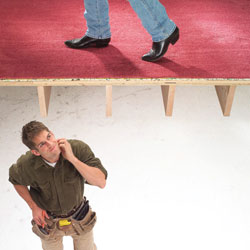| |
Whether your home is old, new or a remodel, squeaky floors and stairs are a common and annoying occurrence.
Hardwood flooring isn't the only flooring material that can get noisy either.
If you have wooden joists and a plywood subfloor (most homes do), you can experience the squeaks and creaks that occur when wood materials shrink.
Typically, wooden materials contain moisture. As time goes by, the wood dries out and shrinks, causing squeaky stairs, steps and floors. Other problems from missed nails or loose screws can create a moaning and groaning floor. With just a few tools and these tips and tricks, you can easily fix your squeaky floors and steps.
Accessing the Joists
If you can access the joists from below, then you're in luck. This can be an easy fix if you can get to the joists. Basements and crawlspaces are easy places to fix a squeaky floor or staircase.  Have someone walk on the floor where the squeak is located. A knock or two from above can help you to pinpoint the location of the squeak. Once you're sure of the squeak spot, you can fill in the gap that's between the joist and the subfloor. A small wooden shim and some wood glue is all you need. Lightly tap the shim in the space above the joist. Don't' hammer it all the way in just enough to fill the gap; otherwise you might raise the floor.
Have someone walk on the floor where the squeak is located. A knock or two from above can help you to pinpoint the location of the squeak. Once you're sure of the squeak spot, you can fill in the gap that's between the joist and the subfloor. A small wooden shim and some wood glue is all you need. Lightly tap the shim in the space above the joist. Don't' hammer it all the way in just enough to fill the gap; otherwise you might raise the floor.
There are also kits available that can help to end squeaks. A threaded rod and plate is secured to the subfloor where the squeak is suspected to be. Then, the threaded rod attaches to another mounting plate on the joist, and screws in place, pulling the subfloor tightly against the joist.
Working from the Top
Unfortunately, many subfloors don't have access to the joists. In this case, working directly above from the actual squeak is necessary. You still need to secure the loose subfloor to the joist, without making a noticeable mark. Snap off or break away screws are used to stop squeaks in their tracks. Once the screw is driven into the joist from above, it is broken off below the flooring to hide it. For carpet, add a bit of scotch tape to the screw to prevent snags in your carpet. Wooden flooring is a little tougher and may require a pilot hole be drilled first.
|
|
Putty is then used to seal the hole. Many break away screw kits come with all of the tools and equipment you need to drive, hide and break the screws.
Stairs
Stairs are an easy fix; if you can find all of the squeaks. A few wooden shims and some wood glue can easily take care of squeaky steps and risers. Simply drive a few shims through the backside of the risers and treads and cut them off flush with a utility knife. Shoe molding attached to the edge of the risers and treads can also help loose and loud stairs stay in place.
.

